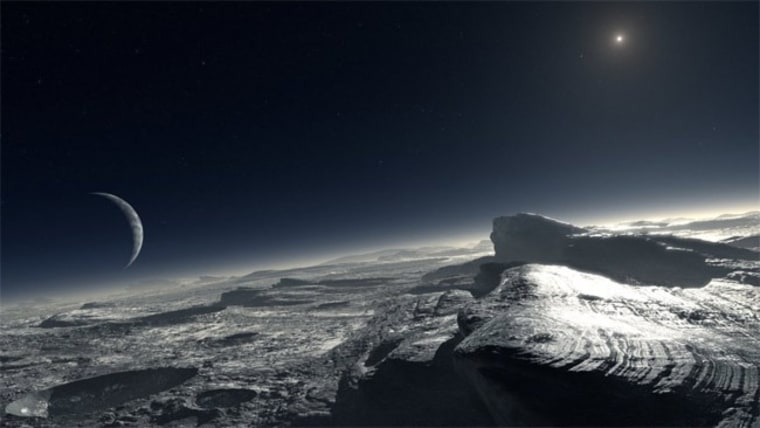The shrinking ice cap around Earth’s North Pole may be hedging in on Santa’s territory, but there are plenty of other frigid territories in the solar system where he could set up shop. Here we tour of some of the most shiver-inducing spots in the solar system.
Mars
If Santa is looking for another snowy spot for his workshop, the northern polar regions of Mars offers an out-of-this-world option. Last year, NASA’s Phoenix Mars lander observed snow falling in Mars’ northern Vastitas Borealis region, where it landed on May 25, 2008 to dig below the surface in search of water ice. Trenches dug by the lander’s robotic arm did indeed expose subsurface ice, shedding more light on the history of water on the red planet. In addition to the slight snowfalls, Phoenix observed frost forming on the Martian surface around it as winter began to set in in the northern hemisphere – the lander is thought to have been covered in ice and frost since NASA lost contact with it in November 2008.
Titan
Lakes of liquid methane and ethane are thought to dot the landscape of this Saturnian moon, in an environment more frigid than Antarctica. But despite its overall colder state, the wind, rains and tectonic processes on Titan make it one of the closest Earth analogs in the solar system, scientists say. While the satellite’s average surface temperature of minus 292 degrees Fahrenheit (minus 180 Celsius) keeps water frozen solid, liquid methane and ethane exist and could provide a haven for life.
Enceladus
Instead of precipitation raining down on its surface, Saturn’s chilly moon Enceladus has geysers of gaseous water that erupt on its surface — a process called cryovolcanism. There is strong debate over the exact composition of the planet and the plumes that spew from its surface. Some argue that the moon features any icy surface layer over a region of flowing water, while others argue that it is a frigid body of solid ice and rock.
Europa
Jupiter’s moon Europa is also an icy world, thought to feature a surface veneer of water ice (at a temperature of almost minus 300 degrees Fahrenheit, or minus 184 Celsius) with a possible liquid water ocean underneath. The icy surface could be good for winter skating, as it is one of the smoothest in the solar system, marked by some cracks and streaks, but with relatively few craters. But despite the icy crust and frigid surface temperatures, some scientists think that heat from the moon’s inner dynamo and the tidal pull of Jupiter could keep the ocean warm enough to support life.
Comets
If the sleigh won’t cut it, Santa could always hitch a ride to a comet. These solar system bodies may not seem cold as they periodically blaze across the night sky, but they are actually collections of dust, water ice, and bits of rock. These “dirty snowballs,” as they are sometimes called, come from the outermost reaches of the solar system — the Kuiper Belt and the Oort Cloud. They develop their telltale tail when their orbit brings them close to the sun and the volatile materials in them are vaporized by solar radiation — but in the outer solar system, they remain frozen chunks of material left from the formation of the solar system.
Uranus
The seventh planet from the sun and one of the solar system’s four gas giants, Uranus is sometimes put into a category called the “ice giants,” along with neighboring Neptune. Uranus’ atmosphere – made up of hydrogen, helium, and water, ammonia and methane ices – is the coldest of any planet in the solar system, with a lowest temperature of minus 371 degrees Fahrenheit (minus 224 degrees Celsius).
Pluto
Earlier this year, scientists determined that Pluto’s atmosphere is warmer than previously thought, warm being a relative term. The air over the dwarf planet’s surface is still a frigid -292 degrees Fahrenheit (-180 degrees Celsius), while its face is -364 degrees Fahrenheit (-220 degrees Celsius). Since its demotion from planet status in 2006, Pluto has been grouped in with a class of bodies known as Kuiper Belt objects that extend out to a distance of 100 times that from the sun to the Earth.
Space itself
While all the worlds above are much chillier than any place on Earth, one of the coldest spots in space is space itself. The cosmic microwave background radiation that permeates the universe (and is the remnant energy of the theoretical Big Bang) has a temperature of 2.725 degrees Kelvin – that’s minus 455 degrees Fahrenheit, or minus 270 degrees Celsius. Might want to install a heater on that sleigh.
Planck spacecraft
The chilliest known spot in space isn’t an icy comet, or even space itself, but is something man-made: the European Space Agency’s Planck spacecraft. On its way to its final orbiting point – where it will observe the remnant radiation of the theoretical Big Bang — the telescope cooled down to its operating temperature of minus 459.49 degrees Fahrenheit (minus 273.05 Celsius). This temperature is just 0.1 Celsius above absolute zero, the coldest temperature theoretically possible in our universe.
Moon’s polar craters
Paradoxically, the coldest (natural) place known in the solar system isn’t some distant object orbiting in the icy Kuiper belt, but instead lies much closer to the sun. In September, NASA’s new Lunar Reconnaissance Orbiter took the temperature of the permanently shadowed craters at the moon’s south pole (where its companion LCROSS probe found water ice deposits after impacting one crater in October). LRO’s instruments found that the craters plunged the mercury to less than minus 397 degrees Fahrenheit (minus 238 Celsius) — colder even than the surface of far away Pluto. Better pack some extra sweaters, Santa!
